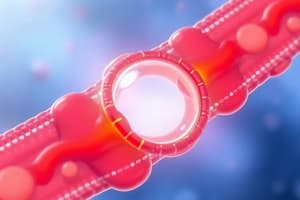Podcast
Questions and Answers
What is the main component of the cell membrane that provides the barrier function?
What is the main component of the cell membrane that provides the barrier function?
- Cell signaling molecules
- Phospholipid bilayer (correct)
- Integral proteins
- Peripheral proteins
What is the arrangement of the hydrophilic heads and hydrophobic tails in a phospholipid bilayer?
What is the arrangement of the hydrophilic heads and hydrophobic tails in a phospholipid bilayer?
- Hydrophilic heads face outward, and hydrophobic tails face inward (correct)
- Hydrophilic heads are in the middle, and hydrophobic tails are on the outside
- Hydrophilic heads face inward, and hydrophobic tails face outward
- Hydrophilic heads are on the outside, and hydrophobic tails are in the middle
What is the characteristic of the cell membrane that allows certain molecules to pass through while keeping others out?
What is the characteristic of the cell membrane that allows certain molecules to pass through while keeping others out?
- Semi-permeability (correct)
- Impermeability
- Permeability
- Selectivity
What is the term that describes the cell membrane as a dynamic, constantly changing structure?
What is the term that describes the cell membrane as a dynamic, constantly changing structure?
What is the function of integral proteins in the cell membrane?
What is the function of integral proteins in the cell membrane?
What is the characteristic of the phospholipids and proteins in the cell membrane?
What is the characteristic of the phospholipids and proteins in the cell membrane?
Flashcards are hidden until you start studying
Study Notes
Lipid Bilayer
- The cell membrane is composed of a phospholipid bilayer, a thin layer of lipid molecules arranged in two layers.
- The phospholipid molecule has a hydrophilic (water-loving) head and a hydrophobic (water-fearing) tail.
- The hydrophilic heads face outward, interacting with the aqueous environments on both sides of the membrane.
- The hydrophobic tails face inward, away from water, and interact with each other.
- This arrangement creates a semi-permeable barrier, allowing certain molecules to pass through while keeping others out.
Membrane Structure
- The cell membrane is a dynamic, fluid structure with three main components:
- Phospholipid bilayer: The main structural component, providing the barrier function.
- Integral proteins: Span the membrane, serving as channels, pumps, receptors, or enzymes.
- Peripheral proteins: Attached to the membrane surface, involved in cell signaling, cell adhesion, and other functions.
- The membrane is semi-fluid, with phospholipids and proteins able to move laterally within the plane of the membrane.
- The fluid mosaic model describes the cell membrane as a dynamic, constantly changing structure.
Lipid Bilayer
- The cell membrane is composed of a phospholipid bilayer, a thin layer of lipid molecules arranged in two layers.
- Phospholipid molecules have a hydrophilic (water-loving) head and a hydrophobic (water-fearing) tail.
- Hydrophilic heads face outward, interacting with the aqueous environments on both sides of the membrane.
- Hydrophobic tails face inward, away from water, and interact with each other.
Membrane Structure
- The cell membrane has three main components: phospholipid bilayer, integral proteins, and peripheral proteins.
- Phospholipid bilayer provides the barrier function and is the main structural component.
- Integral proteins span the membrane, serving as channels, pumps, receptors, or enzymes.
- Peripheral proteins are attached to the membrane surface, involved in cell signaling, cell adhesion, and other functions.
- The membrane is semi-fluid, with phospholipids and proteins able to move laterally within the plane of the membrane.
- The fluid mosaic model describes the cell membrane as a dynamic, constantly changing structure.
Studying That Suits You
Use AI to generate personalized quizzes and flashcards to suit your learning preferences.



